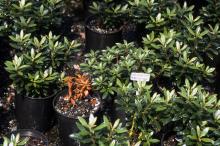Cause Both Phytophthora sp. and Pythium sp. have been isolated in the OSU Plant Clinic. Phytophthora cinnamomi has been reported several times and Phytophthora hydropathica has been found both in irrigation water and from root-crowns of wilting plants. Excess water is the most important factor favoring disease development. These fungi survive unfavorable periods in soil and infected plant debris. Under favorable conditions, spores germinate and infect roots. After infection, the fungus-like microorganism spreads mainly in the inner bark tissues of the root and stems. They survive as various spores in the soil, container media, or infected roots. Movement of infected plants and/or soil can spread this microorganism.
Symptoms Aboveground symptoms are general for root rots and may include yellowing, wilting, or death of the plant. Infected roots are discolored and have few if any feeder roots. When roots are gently pulled, the outer cortex often sloughs off. Infections may progress up into the root crown as indicated by a reddish-brown discoloration of the vascular cambium. A root-crown rot may also be found with some species of Phytophthora.
Cultural control
- Adjust irrigation schedule to keep from waterlogging plants.
- Provide good drainage for plants in beds, fields, or containers. Place containers on gravel beds (4 inches or more deep) to allow drainage. Do not place containers on poly sheets; they can prevent containers from draining into soil and allow contaminated drainage water to spread from the base of one container to another.
- Remove and destroy all infected plants and plant debris.
- Avoid reusing pots from a previous crop for propagation. If pots must be reused then wash off all debris and soak in a sanitizing solution or treat with aerated steam for 30 min.
Chemical control Use fungicides as preventative treatments. Tank-mix and/or alternate products from different groups with different modes of action to prevent the buildup of resistant fungi. The Group 4 and P7 fungicides used to manage oomycetes do not kill these organisms. They can only prevent establishment of the organism before it gets into the plant. They can also prevent continued growth if the organism is already inside the plant thereby delaying symptoms that might have developed. Once chemical activity has subsided with time, the organism can resume growth within infected plants.
- According to IR-4 data, Aliette is safe on this crop. This product provides good control of this disease on many other crops. Do not use with adjuvants. Group P7 fungicide. 24-hr reentry.
- Subdue MAXX or Mefenoxam 2 AQ may be used if tried on a few plants before widescale use. Group 4 fungicides. 48-hr reentry.
- Terrazole 35 WP at 3.5 to 10 oz/100 gal water as a soil drench only at time of seeding or transplanting. Group 14 fungicide. 12-hr reentry.
- Truban 30 WP at 3 to 10 oz/100 gal water is registered for "laurel," which is cross-referenced in IR-4 data as "Kalmia." Group 14 fungicide. 12-hr reentry.
Reference Hong, C.X., Gallegly, M.E., Richardson, P.A., Kong, P., Moorman, G.W., Lea-Cox, J.D., and Ross, D.S. 2010. Phytophthora hydropathica, a new pathogen identified from irrigation water, Rhododendron catawbiense and Kalmia latifolia. Plant Pathology 59:913-921.


